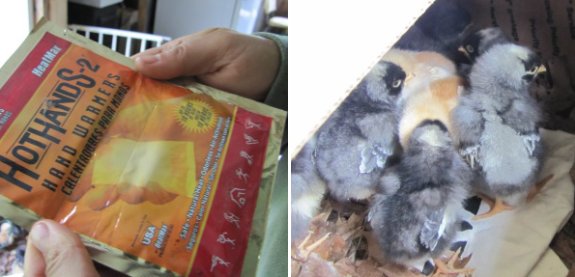
Causes of chick death in the brooder
 Raising chicks from day one
to adulthood seems to be far less fraught with peril than getting them
out of their eggs, but my track record still improved over time.
As long as you can keep your chicks disease free (which our chicken waterer pretty much does for you),
there are only two big causes of chick mortality --- temperature and
predators.
Raising chicks from day one
to adulthood seems to be far less fraught with peril than getting them
out of their eggs, but my track record still improved over time.
As long as you can keep your chicks disease free (which our chicken waterer pretty much does for you),
there are only two big causes of chick mortality --- temperature and
predators.
Heat
Until they're fully
feathered, chicks need an external source of heat to keep them
alive. The mother hen would serve this function in the wild, but
if you're raising chicks on your own, you'll need to resort to a
powered heat source. I was thrilled when I discovered Brinsea's
EcoGlow Chick Brooder,
which mimics a mother hen by letting the chicks snuggle up under a warm
object rather than warming their entire space. I felt like the
contact brooder raised happier chicks than the traditional brood light,
although I was a nervous chick mother and hated not being able to see
the chicks for the first day as they slept off their hatch exertions.

But what if the power
goes out? I learned the hard way that even an hour without heat
can kill your weakest chicks, but we also came up with a stopgap
solution for brooding during short power outages. Putting an
activated hand warmer in the bttom of a small box and closing the lid
partway kept our chicks from anxious peeping until the electricity came
back on. (Our readers also suggested some other good alternatives
here.)
Predators
 I lost a quarter of my first
two batches of chicks to rats. My mother hen did a better job,
but still lost one of her offspring. Only on hatch four did I
figure out that it's not rocket science to keep predators away from my
chicks. Just:
I lost a quarter of my first
two batches of chicks to rats. My mother hen did a better job,
but still lost one of her offspring. Only on hatch four did I
figure out that it's not rocket science to keep predators away from my
chicks. Just:
- Keep your chicks inside the house a little longer, if possible.
- Once you move the chicks outside, seal gaps in the coop so rats have a harder time getting in.
- Shut the chicks in the coop each night until they're six weeks old and too big for rats to attack.
- Keep chicken feed in a sealed container outside the coop.
I lost 25% of hatch one
to rats, 33% of hatch two to a power outage and then to rats, and 18%
of hatch three to introducing the chicks to the mother hen incorrectly
and then to rats. But our final batch of 14 chicks have all
survived their 6 week birthday and will probably make it until we pull
the plug and put them in the freezer in November. That's more
like it!
This post is part of our 2011 Chicken Experiments lunchtime series.
Read all of the entries:
|
Want more in-depth information? Browse through our books.
Or explore more posts by date or by subject.
About us: Anna Hess and Mark Hamilton spent over a decade living self-sufficiently in the mountains of Virginia before moving north to start over from scratch in the foothills of Ohio. They've experimented with permaculture, no-till gardening, trailersteading, home-based microbusinesses and much more, writing about their adventures in both blogs and books.
Want to be notified when new comments are posted on this page? Click on the RSS button after you add a comment to subscribe to the comment feed, or simply check the box beside "email replies to me" while writing your comment.
- Remove comment
- Remove comment
